Indoor roses care at home require special. Beginning flower growers claim that these flowers are moody, after buying they often discard leaves and stop blooming. How to properly care for a home rose so that it pleases with its beauty for a long time is a question that interests many readers.
Material Content:
Indoor roses: varieties for home growing
On sale there are many beautiful miniature types of indoor roses, in total there are more than 20 thousand.
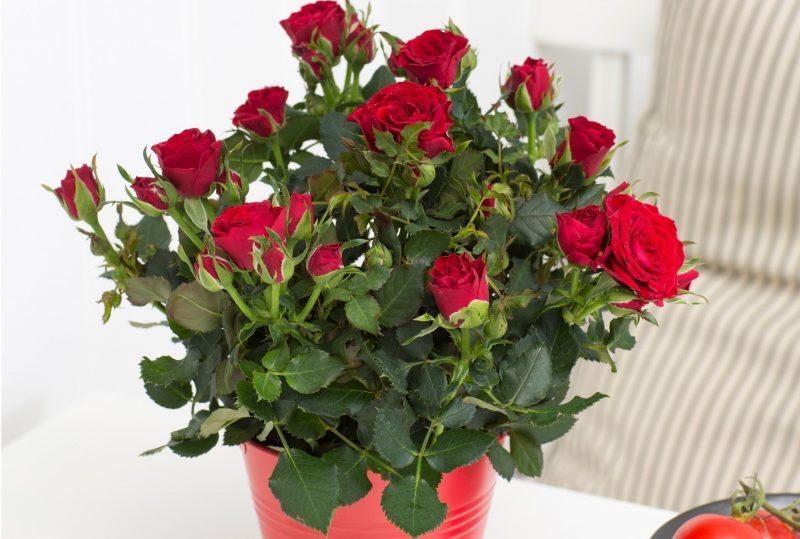
Successful varieties are interesting, which calmly relate to home growing conditions:
- Baby Masquerade. About 30 cm in height, shoots are strong and branched, thorns are almost absent, leaves are small, dark green, flowers from 3 to 4 cm in diameter bloom in inflorescences of 3 to 12 pcs. The color of the flowers changes during flowering. At first it is lemon yellow, then it turns into pink. Pleasant aroma reminiscent of fruit. The variety is resistant to disease.
- Angela Rippon. During flowering, the bush is covered with many small red flowers with a diameter of 3-4 cm with a strong pleasant aroma. Inflorescences consist of 3 to 5 buds. The bushes are compact, about 40 cm high, the leaves are small, dark green. The plant does not require pruning, grows well in small pots.
- Easter Morning. A thick and neat bush, 30 to 40 cm high. The shoots during flowering are covered with double creamy white flowers with a diameter of about 4 cm, with a faint aroma. Inflorescences sometimes consist of 25 buds, flowering continues continuously all summer.
- Fire Princess.Terry small flowers are painted in an orange-red hue, blooming in inflorescences of 3-5 buds.
- Colibri. Thick bushes about 35 cm high, flowers are large, up to 5 cm in diameter, have a pleasant tea aroma. The color of the flowers is yellowish-orange or apricot with a yellow tint. Inflorescences consist of 3 or 5 buds.
The Chinese rose, or hibiscus, differs from indoor roses in the shape and structure of the bush, it does not require rest in the winter and frequent pruning.
Home Flower Care
For a rose, good lighting, regular watering, top dressing and annual transplants are important. Home care is almost no different from outdoor cultivation.

In summer or spring, the plant can be taken out to the balcony.
It is advisable to wrap a dark pot with foil or put it in a white pot so that the roots do not overheat.
Roses are very fond of high atmospheric humidity. They can be placed in a pan with water so that the bottom of the pot is slightly higher than the water level.
Flower arrangement in the room
A rose is placed on a bright eastern window sill, without direct sun. The plant does not tolerate overheating, the air temperature should be no more than 25 ° C.
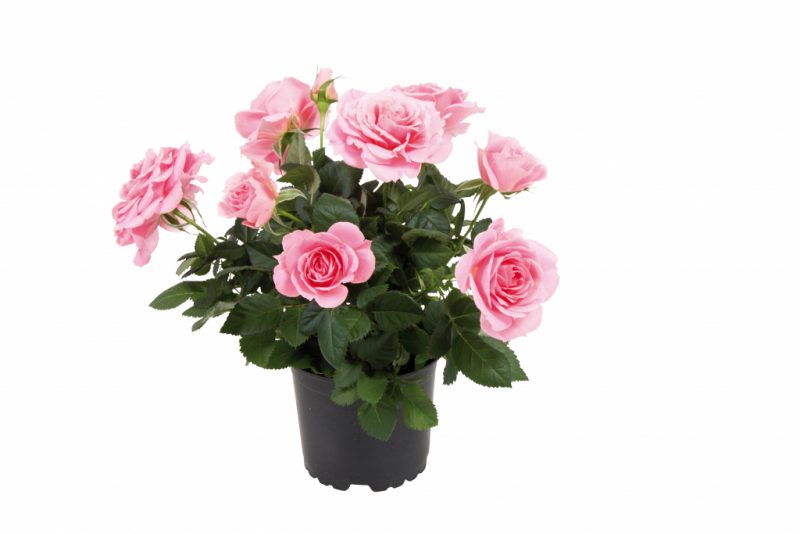
After buying a rose give time to acclimatize. For two weeks it is kept in quarantine, separately from other flowers.
Watering rules at different times of the year
In summer, the rose is regularly and abundantly watered when it is hot, do it every day. The earth should not dry out or be too wet.
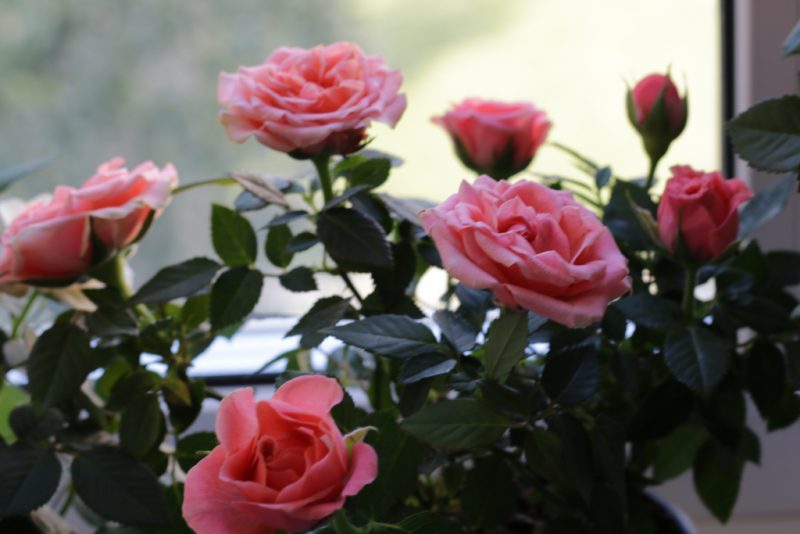
In the fall, they begin preparations for winter peace, reduce watering. In winter, it is easiest to take care of a room rose; watering it is very rare.
In summer, the rose loves daily spraying with water at room temperature. The purchased plant can be sprayed with "Epin" - a drug that increases plant immunity and vitality (dissolve 2 drops per 1 tbsp of water).
Fertilizing and fertilizers
That the rose beautifully blossomed, it needs to be fertilized often. If there are buds on the bush, it is fertilized once a week with fertilizing for roses.
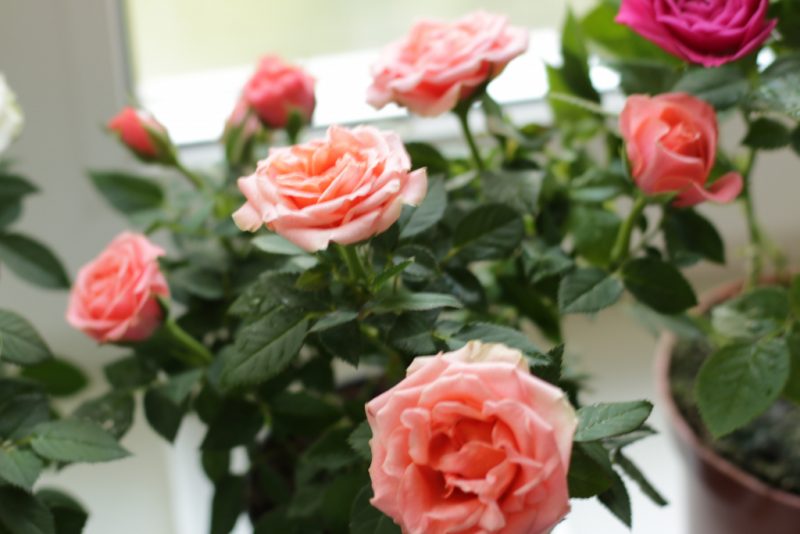
Before flowering, for better growth, the rose is fertilized 1 time in 2 weeks. In winter, feeding is stopped.
If the plant is sick, pests or rot appear on it, feeding is not carried out. First, insects are destroyed, the cause of the disease is eliminated, and then fertilizers are renewed.
Pruning a room rose
Indoor roses need three types of pruning:
- formative (for the formation of a bush and flowering);
- regulatory (to eliminate weak shoots);
- seasonal.
All roses tolerate even the strongest pruning. Nevertheless, it is better to carry it with a clean secateurs. Slices on the shoots are performed at an angle, immediately treated with charcoal or other means of protection.
Before the onset of winter, seasonal pruning is performed on 4 or 5 buds, counting from the ground.
The bud is the place where the leaf petiole grows from. The upper leaves on the trimmed shoots should look outward so that further growth occurs correctly.
Correct formative pruning in early spring promotes abundant flowering. Roses bloom only on the shoots of the current year, so all old branches need to be shortened.
Care after flowering
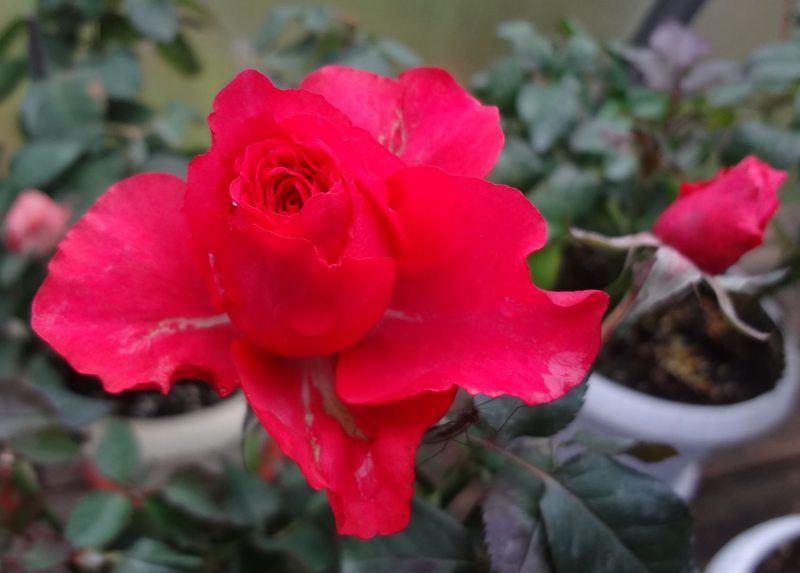
A wilted bud is immediately removed to the first kidney. The plant will spend a lot of energy on the formation of seeds, and flowering may stop. Roses bloom until late autumn, after which the bushes are pruned and transferred to a cool room.
How to care for flowers in winter
The bushes of indoor roses are pruned and placed in a cool place with an air temperature of 5 - 15 ° C. Plants leaves are not discarded, but with an increase in daylight hours they again start to grow. In the spring they are transplanted into new larger pots.
Watering in winter should be very moderate so that the soil does not remain wet. Feeding is not carried out.
Transplanting a room rose
The room rose grows rapidly, gaining strength, and the roots surround the entire earthen lump. Such a plant needs a transplant. A new pot is taken a little more in volume than the previous one. At the bottom put drainage (about 1 cm) and pour soil for the rose.
The soil for planting can be prepared independently from turf, humus soil and sand (ratio 2: 2: 0.5).
After transplanting, the rose is abundantly watered so that water spills out through the drainage holes. Excess liquid is drained from the pan. In the next 2 to 3 weeks, the plant does not fertilize.
Methods of propagation of flowers
Roses are propagated by cuttings and seeds. For cuttings, you can use branches cut at any time of the year. Spring or summer shoots with buds or flowers are more likely to root.
- Cuttings are cut off when the buds are already stained, it is important that they have sleeping buds.
- The length of the cuttings should be from 5 to 12 cm. If the shoot is longer, it is cut into several three-node cuttings. The cut is done obliquely, right under the kidney.
- The shoot should have 3 - 4 leaves on the trunk, for better rooting, leaf plates can be cut to half length. The lower leaves from the shoots are removed.
Immediately after cutting, the cuttings are planted in a mixture of peat and sand or simply in the sand. You can root long branches of roses in the water. To accelerate the formation of roots, before planting in the soil, the sections are treated with a growth stimulator or root.
When planting, cuttings are buried by 1/3 of the length, to the first sheet. The soil is slightly compacted and moistened, then covered with a film or a jar.
Cuttings do not need abundant watering, it is much more important to maintain the air temperature not lower than 18 ° C. Better rooting occurs if the soil temperature is 22 - 25 ° C.
Cuttings should be put in a bright place, but not in direct sunlight. The daylight hours must be at least 15 hours. For the prevention of fungal diseases, one week after planting, you can spray the seedlings with a solution of Fundazole.
Cuttings root in 3 to 5 weeks, this can be determined by the growth of new leaves. When this happened, the greenhouse is removed, and each stalk is planted in a separate pot with light and fertile soil.
On young roses, flowers appear in August or September. But it is better to cut off the first buds so that the plant does not deplete and winter well.
Disease and Pest Prevention
If the air in the apartment is dry and the rose is rarely sprayed, a spider mite may appear on the leaves. In the fight against it, acaricides are used, which process the plant several times with an interval of 7 days.

Rose can get powdery mildew, which results in the formation of a light ash coating. For spraying use antifungal drugs of systemic action, for example, Fitosporin 1 tsp. on 1 liter of water.
In order not to be tormented by the question of why the leaves turn yellow at the roses purchased in the store, it must be treated with fungicides and Fitoverm from pests. You can put Gliocladin tablets (1 pc. Per 300 ml of soil) in the soil.
Common growing problems
After buying a rose, it often starts to drop leaves.
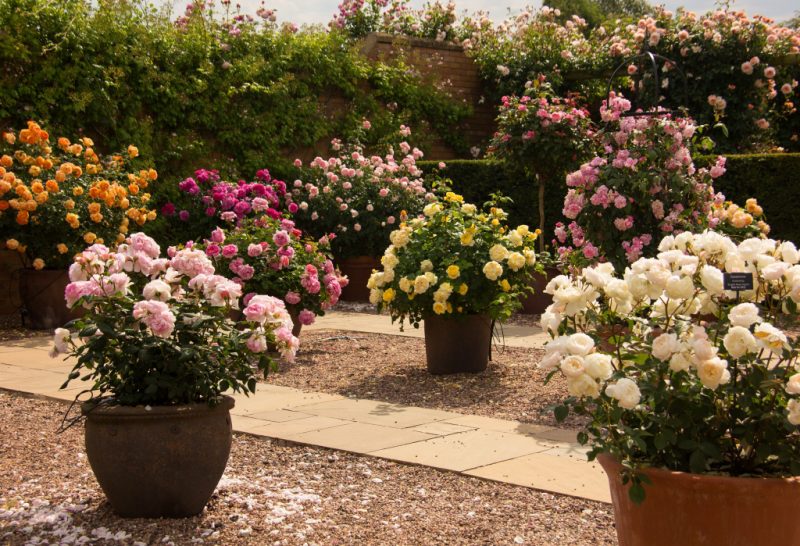
This may be due to several reasons:
- the stress that the plant experienced during transportation;
- fungal diseases;
- insect pests;
- dry air in the apartment.
If the rose is greatly weakened, it is best to cut it 4 to 5 buds above the ground and cover it with a bag or a clear plastic bottle. Water and air regularly until new leaves begin to grow.












